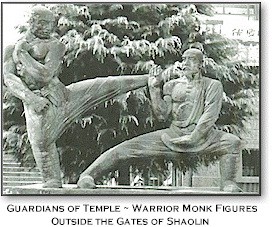Wado Ryu China,
Okinawa and Kushanku China,
Okinawa and Kushanku |
 |
Other than the seemingly endless
discourse and discrepancies on the history of karate itself, perhaps no
other subject within the area of martial arts has generated as much
historical variance as that of Kata.
 Neither Japanese nor Okinawan in
origin, the most accurate of historical records tell us that the earliest
forms of kata probably originated in India, during or just after the time of
the enlightenment of Buddha. As Buddhism spread outside of India, it
established its strongest foothold in China, a nation deeply awash in a
history of mysticism, spirituality, and -- war. While emphasizing unity of
all living things, Buddhism's devotees, acolytes and priests were, nonetheless,
not insulated from the internal and external strife and conflict that marked
their country's early history, and as their monasteries and faith came
increasingly under attack, defense became a necessity. It was that necessity
that gave birth to the now-legendary Warrior Monks of the Shaolin.
Neither Japanese nor Okinawan in
origin, the most accurate of historical records tell us that the earliest
forms of kata probably originated in India, during or just after the time of
the enlightenment of Buddha. As Buddhism spread outside of India, it
established its strongest foothold in China, a nation deeply awash in a
history of mysticism, spirituality, and -- war. While emphasizing unity of
all living things, Buddhism's devotees, acolytes and priests were, nonetheless,
not insulated from the internal and external strife and conflict that marked
their country's early history, and as their monasteries and faith came
increasingly under attack, defense became a necessity. It was that necessity
that gave birth to the now-legendary Warrior Monks of the Shaolin.
It is now strongly believed that
the earliest forms of bujutsu and karate ascended from the remnants of the
defensive systems borne of the Warrior Monks of Shaolin, and subsequently
disclosed to the upper classes of citizenry of the island of Ryukyu, or,
Okinawa, in the mid-1700's. Introduced by emissaries of China's ruling
class, (known as the Sapposhi) as trade flourished between the two kingdoms,
Okinawa's governing class quickly, and vigorously cultivated these arts as a
means of domestic law enforcement. In fact, historical records show that in
1756, one such emissary dispatched by China made a far more lasting
impression on the Imperial Courts of Okinawa than all others before him --
an impression that would carry his name and his namesake down through
the centuries, weaving it forever into the fabric of traditional karate we
know  and practice even today -- his name was Kushanku.
and practice even today -- his name was Kushanku.
"Described as an expert
of the Chinese hand art of Kempo (more specifically, kumiai jutsu), shipping
records reveal that Kushanku, with a retinue of aides traveled to Okinawa
with the Ching Sapposhi, Guan Ki, during his trade excursion in 1756. The
historian Shiohara's description of Kushanku's demonstration of his fighting
art leaves little to question, and the description remains the most reliable
chronicle surrounding Chinese civil fighting traditions in early Okinawa.
There can be no doubt that Kushanku and his disciples gave a public display
of the Chinese fighting disciplines, and were likely engaged in transmitting
to people of wealth, position and power." (Patrick McCarthy)
Today, it can be said that the
essence of all kata we practice lay deep in the historical mists of those
early years in the mountains of Okinawa. Hundreds of years later, it would
be an Okinawan who would travel outside the Ryukyu kingdom, and bring the
long-secret art of Te to the shores of Japan; his name -- Gichin Funakoshi;
the man who would become known as The Father of Modern Karate, and the man
who would also become the first sensei for another Father of Karate;
Hironori Ohtsuka, Meijin -- Master of Masters.

 Neither Japanese nor Okinawan in
origin, the most accurate of historical records tell us that the earliest
forms of kata probably originated in India, during or just after the time of
the enlightenment of Buddha. As Buddhism spread outside of India, it
established its strongest foothold in China, a nation deeply awash in a
history of mysticism, spirituality, and -- war. While emphasizing unity of
all living things, Buddhism's devotees, acolytes and priests were, nonetheless,
not insulated from the internal and external strife and conflict that marked
their country's early history, and as their monasteries and faith came
increasingly under attack, defense became a necessity. It was that necessity
that gave birth to the now-legendary Warrior Monks of the Shaolin.
Neither Japanese nor Okinawan in
origin, the most accurate of historical records tell us that the earliest
forms of kata probably originated in India, during or just after the time of
the enlightenment of Buddha. As Buddhism spread outside of India, it
established its strongest foothold in China, a nation deeply awash in a
history of mysticism, spirituality, and -- war. While emphasizing unity of
all living things, Buddhism's devotees, acolytes and priests were, nonetheless,
not insulated from the internal and external strife and conflict that marked
their country's early history, and as their monasteries and faith came
increasingly under attack, defense became a necessity. It was that necessity
that gave birth to the now-legendary Warrior Monks of the Shaolin. and practice even today -- his name was Kushanku.
and practice even today -- his name was Kushanku.